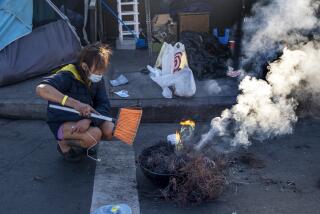How to: Get a Broken Traffic Light Fixed
- Share via
The city’s Bureau of Traffic Operations oversees about 4,000 intersection signals and keeps about 400,000 traffic light bulbs lit. Only New York City, with 6,000 such intersections, has more. This information was compiled by Mary Helen Berg from an interview with David Royer, principal engineer for the Bureau of Traffic Operations, Department of Transportation. Q: Whom do I notify if I see a broken traffic light?
A: Report any traffic light malfunction to (213) 485-2265 between 7 a.m. and 5 p.m. Monday through Friday. For emergencies during evening or weekend hours, call (213) 485-2046. Note the intersection and be able to describe the problem.
Q: How long will it take to fix the signal?
A: Anywhere from one hour to several days, depending on the problem. Emergency crews are on call 24 hours a day to handle situations such as an intersection that has no working signals.
Q: Is there a regular maintenance schedule for lights?
A: No. Because of budget constraints, today there is almost no preventive maintenance and no routine inspection of the system. In fact, although the city has about 1,000 more signalized intersections than it did 20 years ago, the number of crews working on the system is about the same as it was in the 1970s.
Q: It seems some intersections are overloaded with signals. Why do we need more than one light each direction per intersection?
A: Los Angeles follows state-recommended guidelines and installs three signals at each intersection where two or more lanes of traffic run in each direction. That means a light on the right, one on the left and one above the intersection in each direction. This adds up to 12 traffic signals and eight pedestrian indicators per lighted intersection, for an average cost of $65,000.
Q: Sounds complicated. How does the traffic light system run?
A: About 400 intersections in Downtown, Westwood and other congested areas are managed through a central computerized system, the Automated Traffic Surveillance and Control. These intersections use detectors to “see” traffic and automatically decide on the best timing for the lights. However, most of the city’s signalized intersections have independent microprocessors to control the timing of the lights.
Q: What does it cost to maintain the system?
A: The maintenance budget is $15 million, including $5 million for salaries. The Bureau of Traffic Operations employs 150 signal workers, seven emergency crews, four wrecking teams, three new-signal and six heavy-maintenance crews.
Q: Are there any new signalized intersections in the works?
A: Each year the city authorizes about 25 new intersections. The traffic bureau expects to install 20 new signals by July; 40 more are in development, and a computerized system is planned for Hollywood.
More to Read
Sign up for Essential California
The most important California stories and recommendations in your inbox every morning.
You may occasionally receive promotional content from the Los Angeles Times.













